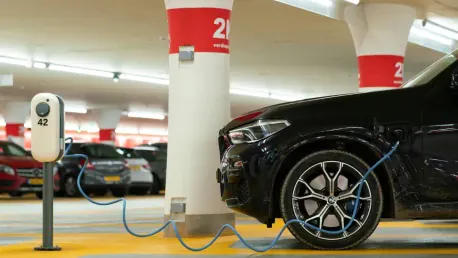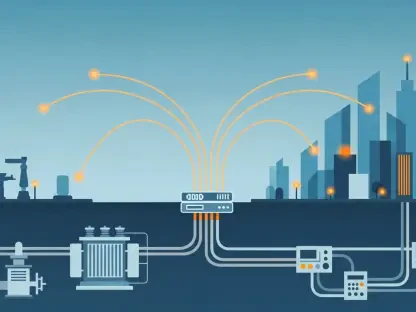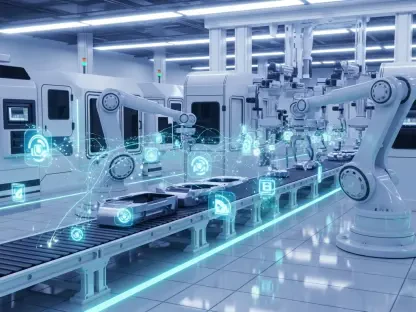The electric vehicle (EV) market is rapidly expanding, and with it comes the need for a robust and user-friendly charging infrastructure. The integration of Internet of Things (IoT) technology into EV charging systems promises to revolutionize the way we charge our vehicles, making the process more efficient, secure, and convenient. This article explores the various ways IoT can enhance and secure the EV charging experience, ensuring a seamless transition for consumers.
Enhancing the Public Charging Experience
Recent advancements in electric vehicle technology have brought the need for more accessible and efficient public charging stations to the forefront. With a growing number of electric vehicles on the road, enhancing the public charging experience has become a crucial goal for both the government and private sector. Improved infrastructure, faster charging times, and user-friendly interfaces are key factors that contribute to a better public charging experience.
The Importance of Seamless Public Charging
For EVs to gain widespread adoption, the public charging experience must be as convenient and intuitive as possible. Many potential EV buyers lack access to off-street parking, making public charging infrastructure crucial. This is especially important for long road trips and ride-hailing services, where reliable and efficient charging is essential to success. To meet these needs, public charging infrastructure must be available, reliable, and easy to use, thereby alleviating concerns that new adopters may have.
Ensuring a seamless public charging experience involves integrating multiple touchpoints, including the charging dock, payment systems, and user interfaces, to provide a cohesive and straightforward process for consumers. This is particularly important for individuals who rely on public chargers as their primary source of vehicle power. A smooth charging experience can significantly impact consumer satisfaction and confidence in transitioning to EVs, contributing to the gradual decline of range anxiety—one of the significant deterrents for potential EV buyers.
IoT-Enabled Contactless Payments and Charger Availability
IoT technology can facilitate contactless payments through the vehicle’s infotainment system, eliminating the need for physical payment methods. Drivers can seamlessly settle charges without worrying about carrying cards, cash, or interacting with payment terminals, thus reducing potential points of failure and enhancing convenience. Additionally, IoT can provide continuous updates on charger availability in the vicinity, helping drivers find available stations quickly and easily. This is achieved through real-time data integration, ensuring drivers can plan their trips effectively without enduring long waiting times.
The introduction of IoT-enabled features extends beyond just convenience. By offering such connectivity, the technology addresses issues related to efficiency for both users and operators. For instance, the ability to check availability and even reserve a charging spot can prevent overcrowding and underutilization of facilities, balancing demand and supply more effectively. Users can benefit from advanced booking capabilities, while operators gain insights into usage patterns, enabling them to optimize their services.
Maximizing Uptime and Network Reliability
For charging operators, IoT offers the potential to maximize uptime and increase the visibility and reliability of their networks. By enabling remote monitoring and real-time data analytics, operators can ensure their charging stations are always operational and ready for use. These insights allow for proactive maintenance, where issues can be addressed before they escalate, reducing downtime and enhancing user trust. Additionally, IoT enables operators to effectively allocate resources, ensuring high-demand areas are adequately serviced and minimizing the risk of infrastructure bottlenecks.
Continuous uptime is critical to the successful adoption and utilization of EVs, as reliability concerns could deter potential users. IoT solutions offer a layer of transparency that reassures users about the availability and health of charging stations. Furthermore, remote monitoring capabilities enable dynamic responses to changing conditions, such as weather disruptions or surging demand during peak travel times. By leveraging IoT technology, charging networks become more resilient and adaptable, laying the groundwork for a future where EV charging is as ubiquitous and reliable as conventional refueling stations.
Improving the Driver’s Experience
Deep IoT Integration Across Consumer Touchpoints
Deep IoT integration across all consumer touchpoints in EV charging significantly enhances the driver’s experience. This involves a holistic connectivity approach, encompassing everything from the charging dock to the payment system, ensuring a smooth and hassle-free process for the user. For instance, through IoT, drivers can receive automated notifications about charging status, anticipated completion times, and any potential issues. This not only keeps drivers informed but also allows them to make real-time decisions, optimizing their schedules and reducing downtime.
The broad scope of IoT integration also emphasizes interoperability among various charging networks and service providers. By creating a unified user experience, drivers no longer need to juggle multiple apps or interfaces, simplifying their interaction with different systems. This level of synergy fosters a more inclusive charging ecosystem, breaking down barriers that have previously complicated the EV charging landscape. Deep integration also shifts the focus from mere functionality to providing a pleasurable and user-centered experience, making the shift to EVs more inviting.
User-Friendly and Efficient Charging Kiosks
IoT technology ensures that charging kiosks are user-friendly and function efficiently at scale. Advanced data analytics allow operators to monitor usage patterns, predict peak times, and ensure that stations are effectively managed. This translates into smoother operations and less waiting time for users. Additionally, user-friendly interfaces simplify the charging process, making it accessible to both tech-savvy users and those less familiar with the technology. Features such as intuitive touchscreen displays, multilingual support, and clear instructions enhance the overall user experience.
Furthermore, the adoption of user-friendly and efficient charging kiosks addresses accessibility issues. By standardizing interfaces and creating ergonomic designs, charging stations can accommodate a broader range of users, including those with disabilities. This inclusivity is crucial for the widespread adoption of electric vehicles, ensuring that the benefits of sustainable transportation are accessible to everyone. Efficient kiosks also mean less downtime and fewer operational hitches, establishing a trust framework where users feel confident in the reliability of available charging points.
Unified Payment Systems
The rapid evolution and integration of unified payment systems have greatly streamlined financial transactions, offering consumers and businesses a seamless experience across different platforms. By combining various payment methods into a single, cohesive system, these innovations have eliminated many traditional barriers to financial transactions, enhancing both convenience and security. The adoption of unified payment systems is expected to continue growing, further transforming the financial landscape.
Allowing payment through the vehicle’s infotainment system can greatly improve consumer sentiment towards EV charging. This eliminates the need for drivers to navigate a myriad of on-site QR codes and apps managed by different charging operators, creating a more streamlined and convenient experience. A unified payment system simplifies transactions, making it easier for users to access charging services regardless of the operator. This approach not only enhances user convenience but also reduces the likelihood of payment-related errors, thus improving the overall efficiency of the charging process.
In addition to streamlined payments, a unified system can offer value-added services, such as loyalty programs, bundled charging packages, and integration with other mobility services like car rentals or public transportation. This holistic approach creates a more engaging and rewarding user experience, encouraging repeated use and fostering a loyal customer base. By removing friction points associated with payments, the industry can pave the way for a more customer-centric and fluid charging ecosystem, contributing to the overall appeal of electric vehicles.
Enhancing Security and Efficiency
Building a Robust Security Infrastructure
Collaboration between automakers and charging operators is vital to ensure a secure charging experience. This collaboration not only involves creating reliable consumer touchpoints, such as the charging dock and payment system, but also building a robust security infrastructure to thwart malicious activities at unmanned stations. Issues such as data breaches, unauthorized access, and cyber-attacks present significant risks, making security a priority in the development of public charging infrastructure. By working together, stakeholders can develop standardized security protocols to guard against potential threats.
A secure infrastructure safeguards sensitive information, such as payment details and driver data, creating a safer environment for both operators and users. This involves the implementation of encrypted communication, regular security updates, and stringent access controls. Furthermore, educating users on best practices and providing clear guidelines can empower them to participate actively in maintaining system security. Through comprehensive security measures, stakeholders can build a trust framework that reassures users about the safety of their personal information and the integrity of the charging systems.
OptConnect’s Router Products
OptConnect’s range of router products enhances the security and efficiency of IoT connectivity in EV chargers. These products provide a 4G signal for basic connected functionalities, allow remote monitoring, offer real-time data and analytics, track data usage, and improve efficiency through a multi-tenant system. This comprehensive suite of features ensures charging stations are not only secure but also capable of optimal performance. Remote monitoring capabilities enable operators to detect issues early and address them promptly, reducing downtime and maintaining high service standards.
Efficient IoT connectivity also improves operational efficiency, as operators can manage multiple stations from a centralized platform, ensuring consistent service quality across the network. This level of oversight is critical for scaling operations, as it allows for a more nuanced and responsive approach to managing charging infrastructure. Through enhanced security and robust connectivity, OptConnect’s router solutions contribute significantly to creating a reliable and user-friendly EV charging ecosystem. Operators can focus on delivering superior service, knowing that the foundational technology supporting their operations is both resilient and secure.
Comprehensive Oversight and Management
Operators have the flexibility to monitor their stations or delegate the backend management to OptConnect. This comprehensive oversight enables operators to manage their networks effectively, ensuring a seamless and secure charging experience for consumers. By leveraging real-time data and analytics, operators can gain insights into station performance, user behavior, and operational challenges, allowing them to make informed decisions and optimize their services. This level of management ensures charging networks remain reliable, responsive, and aligned with user needs.
Centralized management also facilitates better resource allocation, ensuring that high-demand areas are adequately serviced and that maintenance schedules are optimized to minimize downtime. Operators can identify trends and patterns, enabling them to anticipate future needs and scale their infrastructure accordingly. Comprehensive oversight is not just about maintaining the status quo but about continuously improving and adapting to the evolving landscape of EV charging. Through strategic management, operators can enhance user satisfaction, build brand loyalty, and contribute to the broader adoption of electric vehicles.
Adding Feature Richness to the Charging Experience
Amid the evolution of electric vehicles (EVs), the need for enhanced charging infrastructure is paramount. By introducing advanced features such as real-time data monitoring, user-friendly interfaces, and seamless payment solutions, the charging experience can be significantly improved for all users.
Integration with Vehicle Infotainment Systems
The integration of charging networks with the vehicle’s infotainment system and backend servers can unlock numerous possibilities, making the charging experience more enriched and streamlined. Drivers can access up-to-date information that aids in making informed decisions, such as charger uptime, demand, and pricing at specific locations. This connectivity ensures that drivers are always aware of the best available options, enabling them to plan their charging activities more effectively and avoid unexpected delays or costs. It also facilitates real-time communication between the vehicle and charging stations, optimizing the charging process.
Moreover, integration with the infotainment system can provide personalized recommendations based on user preferences and driving patterns. This can include suggestions for charging locations with amenities, such as restaurants or shopping centers, enhancing the overall convenience and appeal of the charging experience. By creating a more engaging and tailored experience, infotainment system integration can significantly improve user satisfaction and encourage more people to adopt electric vehicles. It provides a seamless connection between the driver, vehicle, and charging network, making the entire process more intuitive and user-friendly.
Cloud-Based Generative AI Voice Assistants
An innovative perspective is the potential integration of a cloud-based generative AI voice assistant into the EV system. This assistant would notify drivers when the vehicle’s charge is low and recommend the best available charging stations based on the driver’s specific needs, such as proximity to restaurants or other amenities. The AI assistant can streamline the decision-making process, offering route suggestions and real-time updates on station availability, thus enhancing the overall driving experience. By understanding and adapting to the driver’s preferences, the assistant can provide a personalized and efficient charging experience.
In addition to suggesting charging stations, a generative AI voice assistant can offer additional services, such as scheduling maintenance, providing traffic updates, and even integrating with smart home devices. This level of connectivity transforms the EV from a mere mode of transportation to a central hub in a connected ecosystem, enhancing the driver’s lifestyle and convenience. The potential for generative AI to learn and evolve based on user interactions means that the service can continuously improve, offering more accurate and relevant suggestions over time. This adaptability makes AI a valuable tool in enhancing the EV charging experience.
Transparency and Convenience
By connecting the vehicle to a universal grid network through IoT, drivers can access transparent information that prevents unexpected peak hour rates and enhances the overall convenience of EV charging. This transparency can significantly improve the consumer experience and encourage more people to switch to EVs. Real-time data on pricing, availability, and demand allow drivers to make informed decisions, reducing the likelihood of facing unwelcome surprises. This level of transparency fosters trust and confidence, essential elements for the wide-scale adoption of electric vehicles.
Convenience is further enhanced by the ability to integrate charging activities with other aspects of the user’s life. For example, drivers can schedule charging sessions during off-peak hours to take advantage of lower rates or coordinate with their daily routines to minimize disruption. The provision of detailed information through IoT ensures that users have all the necessary tools to optimize their charging activities, making the process as straightforward and hassle-free as possible. By offering a transparent and convenient charging experience, the EV industry can address one of the primary concerns of potential buyers, paving the way for a more sustainable future.
Overcoming Challenges in the Rapid Expansion of Charging Infrastructure
Collaboration Between Automakers and Charging Operators
The rapid expansion of charging infrastructure poses challenges for automakers and charging operators. Collaboration is essential to ensure that the charging experience is as seamless as possible, involving reliable consumer touchpoints and robust security measures. By working together, industry stakeholders can develop standardized solutions that enhance interoperability and user-friendliness across different networks. This cooperative approach ensures that the growing demand for charging infrastructure is met efficiently and effectively, reducing the potential for fragmentation and inconsistency.
Effective collaboration also involves sharing best practices and pooling resources to address common challenges. This can include joint investments in research and development, collaborative pilot projects, and the establishment of industry-wide standards for security and performance. By fostering a culture of collaboration, the industry can create a more cohesive and resilient charging ecosystem that better serves the needs of all stakeholders. This joint effort is crucial for the long-term success and scalability of EV infrastructure, ensuring that the rapid growth of electric vehicles is supported by a robust and reliable charging network.
Leveraging IoT Opportunities
While the EV industry is moving quickly, fully leveraging IoT could significantly improve the charging experience. By integrating IoT technologies, the industry can offer tangible advantages over traditional refueling, making the switch to EVs more appealing for consumers. IoT-enabled solutions can enhance convenience, efficiency, and security, addressing many of the current pain points associated with EV charging. For instance, real-time data analytics can optimize station performance, while remote monitoring can prevent issues from escalating into significant disruptions.
Furthermore, IoT can facilitate the development of new business models and services that add value for consumers. This can include subscription-based charging plans, dynamic pricing schemes, and integrated mobility solutions that combine EV charging with other forms of transportation. By exploring and capitalizing on IoT opportunities, the industry can create a more diverse and appealing landscape for EV users, encouraging broader adoption. The ongoing innovation and adaptation driven by IoT will play a critical role in shaping the future of EV charging, making it more accessible and attractive.
Building the Wings While Flying
The electric vehicle (EV) market is growing rapidly, necessitating the development of a comprehensive and user-friendly charging infrastructure. The incorporation of Internet of Things (IoT) technology into EV charging systems has the potential to transform how we power our vehicles, making the process far more efficient, secure, and convenient. IoT technology allows for real-time monitoring and management of charging stations, optimizing energy usage and reducing downtime. Furthermore, IoT can enhance security by enabling features such as user authentication and automated maintenance alerts, thereby safeguarding both the charging infrastructure and the vehicles themselves. The convenience factor is also significantly improved, as IoT facilitates remote access to charging status, availability, and scheduling through smartphone applications. This article delves into the myriad ways IoT can enhance and protect the EV charging experience, ensuring a smooth and seamless transition for consumers into the electrified future.









